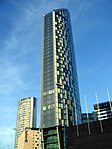Disclosure and Barring Service
The Disclosure and Barring Service (DBS) is a non-departmental public body of the Home Office of the United Kingdom. The DBS enables organisations in the public, private and voluntary sectors to make safer recruitment decisions by identifying candidates who may be unsuitable for certain work, especially involving children or vulnerable adults, and provides wider access to criminal record information through its disclosure service for England and Wales.The DBS was formed in 2012 by merging the functions of the Criminal Records Bureau (CRB) and the Independent Safeguarding Authority (ISA) under the Protection of Freedoms Act 2012. The DBS started operating on 1 December 2012. It has offices in Liverpool and Royal Wootton Bassett. Its equivalent agencies are Disclosure Scotland in Scotland and Access Northern Ireland in Northern Ireland, although convictions from every part of the UK appear on it.
Excerpt from the Wikipedia article Disclosure and Barring Service (License: CC BY-SA 3.0, Authors).Disclosure and Barring Service
Queensway, Liverpool Vauxhall
Geographical coordinates (GPS) Address Nearby Places Show on map
Geographical coordinates (GPS)
| Latitude | Longitude |
|---|---|
| N 53.407805555556 ° | E -2.98925 ° |
Address
Moorfields
Queensway
L2 2HT Liverpool, Vauxhall
England, United Kingdom
Open on Google Maps





